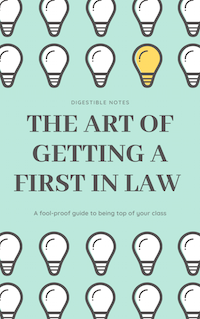Assault and Battery
Introduction
⇒ Technically assault and batter are two separate crimes: in brief, a battery involves an unlawful and unwanted contact with the body of another, while an assault involves causing another to apprehend the possibility of imminent unlawful contact.
1) Assault
Definition
⇒ The definition of assault is as follows:
- Actus Reus: the defendant caused the victim to apprehend imminent unlawful violence.
- Mens Rea: the defendant intended or was reckless that the victim would apprehend imminent unlawful force.
⇒ Assault is a common law offence, so it is not explicitly defined in the Offences Against The Person Act 1861.
⇒ Words can constitute an assault, as seen in the case of R v Ireland [1998].
Apprehension of force
⇒ If the victim suffers no apprehension of force there cannot be an assault.
⇒ So, if the defendant utters horrible threats to the victim, which do not unsettle the victim at all (for example, the victim does not believe the threats) there can be no assault.
The Art of Getting a First in Law - ONLY £4.99
FOOL-PROOF methods of obtaining top grades
SECRETS your professors won't tell you and your peers don't know
INSIDER TIPS and tricks so you can spend less time studying and land the perfect job
We work really hard to provide you with incredible law notes for free...
The proceeds of this eBook helps us to run the site and keep the service FREE!

Meaning of ‘imminent’ harm
⇒ It is well established that a threat to be violent at some point in the distant future cannot generally be an assault e.g. telling someone you will beat them up next week is not an assault.
⇒ However, Lord Steyn in R v Ireland [1998] indicated that a fear of violence "within a minute or two" might be sufficient to constitute an assault.
Must the threat be of touching from the defendant?
⇒ It does appear possible that the threat could be touching from someone or something other than the defendant: for example, in R v Dume [1986] it was an assault for the defendant to threaten to set an animal on the victim.
Does the defendant have to intend to carry out the threat?
⇒ The defendant does not need to intend to carry out the threat for there to be an assault. See, for example, the case of Logdon v DPP [1976].
Conditional threats
⇒ What is the position if the defendant says, "I will punch you unless you retract what you just said"?
⇒ On the one hand it could be argued that this isn't an assault as the victim could avoid harm by retracting the statement, and therefore could not have foreseen imminent force. However, it could also be argued that it is an assault because by acting in a lawful way (staying silent) they may be subject to violence. There is no clear guidance on this issue.
Does an assault require an act?
⇒ In Fagan v Metropolitan Police Commissioner [1969] it was suggested by the Divisional Court that an assault requires proof of a positive act and cannot be committed merely by an omission.
- For example, it would seem harsh to say a man is guilty of an assault if he is looking at a house, then a woman appears at the window, frightening her, yet he does not move.
⇒ Nevertheless, it may be possible to argue an omission is an assault where the defendant is acting unlawfully. For example, if you are trespassing in someone else’s garden and the homeowner notices you, and is startled by your presence, it may be an offence to remain there.
2) Battery
Definition
⇒ The definition of battery is as follows:
- Actus Reus: the defendant touched or applied force to the victim.
- Mens Rea: the defendant intended or was reckless as to the touching or applying force to the victim.
⇒ A battery can be committed without the victim suffering any kind of injury. For example, touching can constitute a battery (Collins v Wilcock [1984]), even if the victim did not feel the touching (R v Thomas (1985)).
⇒ A battery can also be committed through an object. See, for example, the case of Fagan v Metropolitan Police Commissioner [1969] where the battery was committed by placing a car on the victim’s foot.
Batteries without the application of force
⇒ For example, would it be battery if a person sets a booby trap and their victim falls into it? → the decisions to date suggest these are batteries (R v Martin (1881)).
⇒ Although Lord Ackner stated, obiter, in R v Savagespan> that battery DOES require the application of force, it is more commonly accepted that battery does not require a direct application of force. See, for example, the cases of DPP v K [1990] and Haystead v DPP [2000].
Can every day touchings amount to battery?
⇒ Some touchings are part of everyday life and, therefore, the law would not regard these as batteries (Collins v Wilcock [1984]).
⇒ Although the law is clear on this, it is not clear why exactly everyday touchings are not battery. There are two possible explanations:
- Implied consent: in a very crowded place (e.g. the London Underground), where touching is common, people impliedly consent to such contact.
- Necessity: modern life would be impossible if it were illegal to touch anyone without their consent. Imagine trying to run a nightclub if it were illegal for people to touch each other!
Must the battery be hostile?
⇒ The commonly accepted view is that a battery need not be hostile, rude, or aggressive (Faulkner v Talbot [1981]). For example, if you lovingly stroke another’s hair without their consent that would be a battery!
Law Application Masterclass - ONLY £9.99
Learn how to effortlessly land vacation schemes, training contracts, and pupillages by making your law applications awesome. This eBook is constructed by lawyers and recruiters from the world's leading law firms and barristers' chambers.
✅ 60+ page eBook
✅ Research Methods, Success Secrets, Tips, Tricks, and more!
✅ Help keep Digestible Notes FREE

